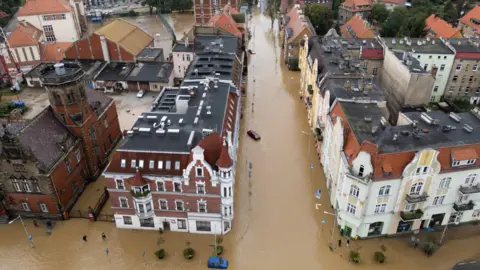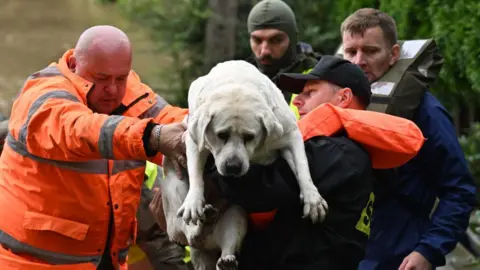Death toll rises in flood-hit Central Europe

 Reuters
ReutersThe death toll from the floods that hit central Europe over the weekend has risen, as more people have died in the Czech Republic, Poland and Austria.
In the Czech Republic, one person drowned in a stream near the town of Bruntal in the northeast of the country, while seven people are still missing.
Four people are known to have died in Poland, although an interior ministry spokesman said the exact cause of death was yet to be determined in at least one case.
And in Austria, two people aged 70 and 80 died in the north-east of the country. One of them, a resident of the village of Höbersdorf, was trying to pump water from his apartment when he drowned, Austrian media reported.
Eight people were recorded over the weekend in Poland, Romania and Austria, where a firefighter died during a flood rescue operation.
While conditions are stable in some parts of central Europe, others are facing increased disruption and risk.
In Slovakia, the overflowing Danube River has caused flooding in the Old Town area of the capital, Bratislava, with local media reporting that the water is over 9m (30ft) high and expected to rise further.
 Getty Images
Getty ImagesHungarian Prime Minister Viktor Orban said on X that he had postponed all his international commitments “due to the severe weather and ongoing flooding in Hungary”.
The highest amount of rain was in the Czech Republic. In the northeastern town of Jesenik, 473mm (19in) of rain has fallen since Thursday morning – five times the monthly average.
Austrian Chancellor Karl Nehammer said the military had been deployed to provide aid to the storm-hit areas. In St Polten, more rain fell in four days than the wettest autumn on record, in 1950.
Polish Prime Minister Donald Tusk said a billion zloty (£197m) would be allocated to flood victims. He added that Poland will also apply for EU aid funds.
Villages and towns were submerged in eastern Romania. Emil Dragomir, the mayor of Slobozia Conachi, told the media that the floods had a very bad impact.
“If you were here, you would immediately cry because people have lost hope, the work of their whole life is gone, there are people left with the clothes they were wearing,” he said.
Thousands of people have been evacuated from Poland, including the staff and patients of a hospital in the town of Nysa. Roads have been severely disrupted and train services have been suspended in many parts of the country.
On Monday morning, the mayor of Paczków in southwestern Poland urged residents to evacuate after water began to overflow from a nearby dam, putting the town at risk.
However, in some parts of Poland, water levels are now falling, according to local officials.
The mayor of the city of Klodzko, Michal Piszko, told Polish media that the water has receded and that the worst indicators are over.
Video footage from Monday morning showed that the streets in the city center that had flooded on Sunday were now dry, although the video also showed the extent of the damage to buildings.
More rain is expected throughout Monday and Tuesday in Austria, the Czech Republic and south-east Germany, where another 100mm (4in) could fall.
Although it may take days for the floodwaters to recede, the weather will improve in central Europe from midweek with drier conditions.
Storm Boris, however, is now set to move south into Italy, where it will strengthen again and bring heavy rain. The Emilia-Romagna region will be hardest hit, with 100-150mm (4-6in) of rain.
This may cause further flooding in the region.
Source link




